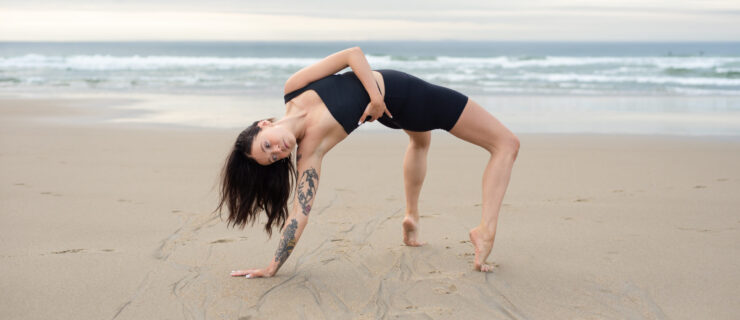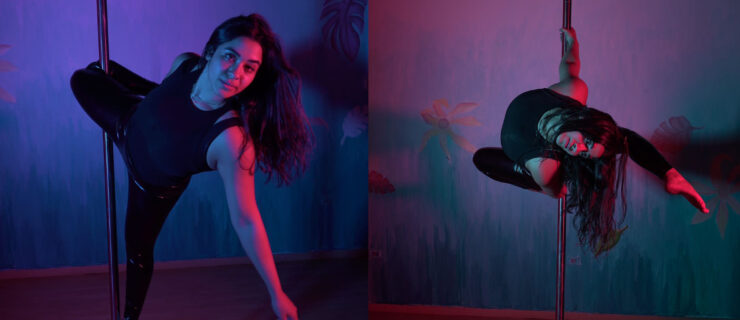Heels Over Head: 5 Tips to Get More Comfortable With Inversions
“Being upside down is important to me,” says Pavan Thimmaiah. After all, an image of an upside-down dancer in a freeze is the logo for his New York City–based PMT House of Dance studio.
And yet, when Thimmaiah was younger, he was so unsure about being upside down that his mother, attempting to help, would sometimes hold him by the ankles to get him comfortable with the feeling.
Indeed, going upside down can be intimidating—whether it’s the fear of falling, the rush of blood to the head or just the disorientation of seeing the world from a different angle. But “if you can go upside down, it provides you more options to express and to move without limitations,” says Thimmaiah. And that’s not just for breakers—modern dancers need this tool for inversions, for instance, and ballet dancers for partnering.
So what does it take to become as confident moving upside down as you are right side up?
Go Back to Basics
The headstand and the handstand are perhaps the most basic versions of being upside down and are thus a good starting place. That’s why Gus Solomons jr would include a “handstand day” at the beginning of the semester for his contemporary classes at New York University’s Tisch School of the Arts and would have students practice them in class throughout the year.
If handstands sound intimidating, start with a headstand, says Thimmaiah. With your forearms in a tripod configuration with your head, gradually raise your legs from a coiled position (knees starting near your elbows, then straightening up). When you’re ready, you can progress to a handstand using a wall for support. Your arms should be straight, about shoulder-width, and fingers spread. Engage your core and glutes to keep your legs and back straight, says Thimmaiah.
Once you’re stable enough to remove your legs from the wall, play: Open and close your legs, or try moving one hand off the floor, paying careful attention to the changes in balance and counterbalance. “It’s a place where you can explore movement,” Thimmaiah says. “It’s not simply a position.”
Conquer Your Fear
Mastering inversions can be as much a mental game as a physical one. If the idea of being upside down scares you, exposure therapy might help. Start with positions that don’t require you to hold up your own weight. While not everyone has an inversion bed, as Solomons does, yoga poses like fish can get you used to having your head upside down while the rest of your body is safely on the floor.
“Look at the movement and break it down into smaller steps,” suggests Amanda Donahue, an athletic trainer at the Joan Phelps Palladino School of Dance and School of the Arts at Dean College. She recommends calming pre-inversion jitters with breathwork or meditation. “If you can control your breath, that’s going to help downregulate your nervous system, so you can be more relaxed and engaged.” A spotter or floor mats can also be used to help you feel safer, she says.
Consider the Benefits
Even if your current work doesn’t call for being upside down often, it’s still a valuable tool. “It’s a way to diversify yourself as a dancer,” says Thimmaiah.
You may be experiencing inversions without even realizing it. “There are many ways of being upside down,” Thimmaiah says. “If you can do a cartwheel, you’re upside down, so it’s a matter of figuring out how that translates.”
Yes, it’s even true in ballet. “Ballerinas are always getting thrown upside down,” says Solomons. “It’s even more critical for them to get comfortable being every which way in space. You’re training your body to do all it can do, and upside down is another possibility. When you get there, you can get used to the idea that seeing the world right side up is not all there is.”
Take it Easy
Being upside down can be especially difficult for people who have low blood pressure, says Donahue. If inversions are making you light-headed or dizzy, take a break, and be sure you’re well-hydrated next time you attempt them.
3 Exercises for Safe Inversions
Upper body, core and grip strength are key to going upside down safely and confidently, says Donahue. She recommends these exercises:
Plank variations:
Start by maintaining a plank position with proper alignment for up to a minute. If you can do that well, try a plank pike, using either socks or sliders to allow the feet to slide towards the hands, lifting the hips up to the ceiling and controlling on the way back to plank. To progress this exercise, you can twist the hips toward one shoulder to engage the obliques. Alternatively, you can lift one leg into arabesque and slide in just one leg, or try placing your feet on a physio ball to shift more weight into the hands.
Farmer carries: With a moderate or heavy dumbbell in each hand, stand tall and walk for 20–40 yards, or 30 seconds to a minute, as if you are carrying heavy grocery bags. Increase distance, time or load to make it harder, or try it with all of the weight in one hand.
Isometric hangs: Use a chair to grab onto a pull-up bar and hold yourself in a pull-up position, making sure that your back is not arched, building up to 30 seconds. You can also hold the down phase of the pull-up, with your arms fully extended.




